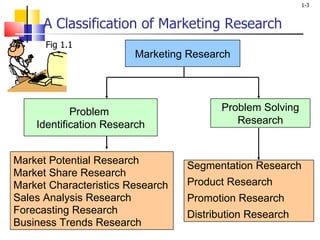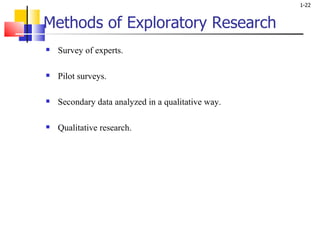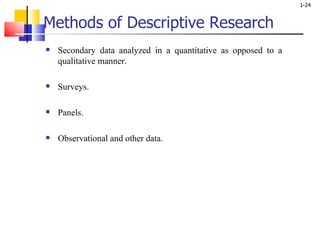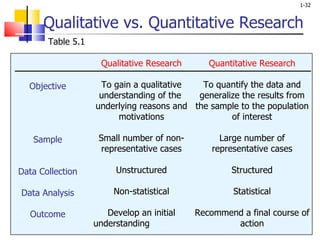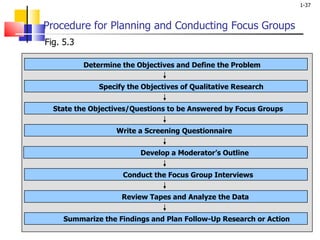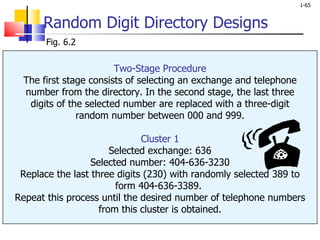Malhotra01.....
- 1. Definition of Marketing Research Marketing research is the systematic and objective identification, collection, analysis, dissemination & use of information for the purpose of improving decision making related to the identification and solution of problems and opportunities in marketing. -Green and Tull
- 2. Classification of Marketing Research Problem Identification Research: Research undertaken to help identify problems which are not necessarily apparent on the surface and yet exist or are likely to arise in the future. Examples: market potential, market share, image, market characteristics, sales analysis, forecasting, and trends research. Problem Solving Research: Research undertaken to help solve specific marketing problems. Examples: segmentation, product, pricing, promotion, and distribution research.
- 3. A Classification of Marketing Research Marketing Research Fig 1.1 Problem Identification Research Problem Solving Research Market Potential Research Market Share Research Market Characteristics Research Sales Analysis Research Forecasting Research Business Trends Research Segmentation Research Product Research Promotion Research Distribution Research
- 4. Problem Solving Research Determine the basis of segmentation Establish market potential and responsiveness for various segments Select target markets Create lifestyle profiles: demography, media, and product image characteristics SEGMENTATION RESEARCH Test concept Determine optimal product design Package tests Product modification Brand positioning and repositioning Test marketing Control score tests PRODUCT RESEARCH
- 5. Problem Solving Research PRICING RESEARCH Pricing policies Importance of price in brand selection Product line pricing Price elasticity of demand Initiating and responding to price changes $ALE PROMOTIONAL RESEARCH Optimal promotional budget Sales promotion relationship Optimal promotional mix Copy decisions Media decisions Creative advertising testing Evaluation of advertising effectiveness Claim substantiation 0.00% APR
- 6. Problem Solving Research DISTRIBUTION RESEARCH Determine… Types of distribution Attitudes of channel members Intensity of wholesale & resale coverage Channel margins Location of retail and wholesale outlets
- 7. Marketing Research Process Step 1: Problem Definition Step 2: Development of an Approach to the Problem Step 3: Research Design Formulation Step 4: Fieldwork or Data Collection Step 5: Data Preparation and Analysis Step 6: Report Preparation and Presentation
- 8. The Role of Marketing Research Fig 1.2 Controllable Marketing Product Pricing Promotion Distribution Variables Marketing Research Marketing Decision Making Providing Information Assessing Information Needs Marketing Managers Market Segmentation Performance & Control Target Market Selection Marketing Programs Uncontrollable Environmental Factors Economy Technology Laws & Regulations Social & Cultural Factors Political Factors Customer Groups Employees Shareholders Suppliers Consumers
- 9. Role of marketing research (MR) The task of marketing research(MR) is to provide management with relevant, accurate, reliable, valid, and current information. Competitive marketing environment and the ever-increasing costs attributed to poor decision making require that marketing research provide sound information. Sound decisions are not based on gut feeling, intuition, or even pure judgment. Marketing managers make numerous strategic and tactical decisions in the process of identifying and satisfying customer needs.
- 10. They make decisions about potential opportunities, target market selection, market segmentation, planning and implementing marketing programs, marketing performance, and control. These decisions are complicated by interactions between the controllable marketing variables of product, pricing, promotion, and distribution. Further complications are added by uncontrollable environmental factors such as general economic conditions, technology, public policies and laws, political environment, competition, and social and cultural changes. Another factor in this mix is the complexity of consumers Marketing research helps the marketing manager link the marketing variables with the environment and the consumers. It helps remove some of the uncertainty by providing relevant information about the marketing variables, environment, and consumers
- 11. In the absence of relevant information, consumers' response to marketing programs cannot be predicted reliably or accurately. Ongoing marketing research programs provide information on controllable and non-controllable factors and consumers; this information enhances the effectiveness of decisions made by marketing managers. Traditionally, marketing researchers were responsible for providing the relevant information and marketing decisions were made by the managers. However, the roles are changing and marketing researchers are becoming more involved in decision making, whereas marketing managers are becoming more involved with research.
- 12. The role of marketing research in managerial decision making is explained further using the framework of the "DECIDE" model. The DECIDE model conceptualizes managerial decision making as a series of six steps. The decision process begins by precisely defining the problem or opportunity, along with the objectives and constraints. Next, the possible decision factors that make up the alternative courses of action (controllable factors) and uncertainties (uncontrollable factors) are enumerated Then, relevant information on the alternatives and possible outcomes is collected. The next step is to select the best alternative based on chosen criteria or measures of success. Then a detailed plan to implement the alternative selected is developed and put into effect. Last, the outcome of the decision and the decision process itself are evaluated.
- 13. D- Decide the topic/problem E- Explore the alternatives C- Check the alternatives I- Identify possible solutions D- Decide and take action E- Evaluate and revise
- 14. MIS- A formalized set of procedures for generating, analyzing, storing and distributing pertinent information to marketing decision makers on an ongoing basic set of procedures. DSS- Information systems that enable decision makers to interact directly with both databases and analysis models. The important components include hardware, communications network, database, model base, software base and the DSS user
- 15. Management Information Systems vs. Decision Support Systems Unstructured Problems Use of Models User Friendly Interaction Adaptability Can Improve Decision Making by Using “What if” Analysis DSS MIS Structured Problems Use of Reports Rigid Structure Information Displaying Restricted Can Improve Decision Making by Clarifying Data
- 16. Research Design: Definition A research design is a framework or blueprint for conducting the marketing research project. It details the procedures necessary for obtaining the information needed to structure or solve marketing research problems.
- 17. Components of a Research Design Define the information needed. Design the exploratory, descriptive, and/or causal phases of the research. Specify the measurement and scaling procedures. Construct and pretest a questionnaire (interviewing form) or an appropriate form for data collection. Specify the sampling process and sample size. Develop a plan of data analysis.
- 18. Classification of Marketing Research Designs Single Cross-Sectional Design Multiple Cross-Sectional Design Fig. 3.1 Research Design Conclusive Research Design Exploratory Research Design Descriptive Research Causal Research Cross-Sectional Design Longitudinal Design
- 19. Exploratory & Conclusive Research Differences Objective: Character-istics: Findings /Results: Outcome: To provide insights and understanding. Information needed is defined only loosely. Research process is flexible and unstructured. Sample is small and non-representative. Analysis of primary data is qualitative. Tentative. Generally followed by further exploratory or conclusive research. To test specific hypotheses and examine relationships. Information needed is clearly defined. Research process is formal and structured. Sample is large and representative. Data analysis is quantitative. Conclusive. Findings used as input into decision making. Exploratory Conclusive Table 3.1
- 20. A Comparison of Basic Research Designs Objective: Characteristics: Methods: Discovery of ideas and insights Flexible, versatile Often the front end of total research design Expert surveys Pilot surveys Secondary data Qualitative research Describe market characteristics or functions Marked by the prior formulation of specific hypotheses Preplanned and structured design Secondary data Surveys Panels Observation and other data Determine cause and effect relationships Manipulation of one or more independent variables Control of other mediating variables Experiments Exploratory Descriptive Causal Table 3.2
- 21. Uses of Exploratory Research Formulate a problem or define a problem more precisely. Identify alternative courses of action. Develop hypotheses. Isolate key variables and relationships for further examination. Gain insights for developing an approach to the problem. Establish priorities for further research.
- 22. Methods of Exploratory Research Survey of experts. Pilot surveys. Secondary data analyzed in a qualitative way. Qualitative research.
- 23. Use of Descriptive Research To describe the characteristics of relevant groups, such as consumers, salespeople, organizations, or market areas. To estimate the percentage of units in a specified population exhibiting a certain behavior. To determine the perceptions of product characteristics. To determine the degree to which marketing variables are associated. To make specific predictions
- 24. Methods of Descriptive Research Secondary data analyzed in a quantitative as opposed to a qualitative manner. Surveys. Panels. Observational and other data.
- 25. Cross-sectional Designs Involve the collection of information from any given sample of population elements only once. In single cross-sectional designs, there is only one sample of respondents and information is obtained from this sample only once. In multiple cross-sectional designs , there are two or more samples of respondents, and information from each sample is obtained only once. Often, information from different samples is obtained at different times. Cohort analysis consists of a series of surveys conducted at appropriate time intervals, where the cohort serves as the basic unit of analysis. A cohort is a group of respondents who experience the same event within the same time interval.
- 26. Longitudinal Designs A fixed sample (or samples) of population elements is measured repeatedly on the same variables. A longitudinal design differs from a cross-sectional design in that the sample or samples remain the same over time.
- 27. Relative Advantages and Disadvantages of Longitudinal and Cross-Sectional Designs Evaluation Criteria Cross-Sectional Design Longitudinal Design Detecting Change Large amount of data collection Accuracy Representative Sampling Response bias - - - + + + + + - - Note: A “+” indicates a relative advantage over the other design, whereas a “-” indicates a relative disadvantage. Table 3.4
- 28. Uses of Casual Research To understand which variables are the cause (independent variables) and which variables are the effect (dependent variables) of a phenomenon. To determine the nature of the relationship between the causal variables and the effect to be predicted. METHOD: Experiments.
- 29. Potential Sources of Error in Research Designs Fig. 3.2 Surrogate Information Error Measurement Error Population Definition Error Sampling Frame Error Data Analysis Error Respondent Selection Error Questioning Error Recording Error Cheating Error Inability Error Unwillingness Error Total Error Non-sampling Error Random Sampling Error Non-response Error Response Error Interviewer Error Respondent Error Researcher Error
- 30. Errors in Marketing Research The total error is the variation between the true mean value in the population of the variable of interest and the observed mean value obtained in the marketing research project. Random sampling error is the variation between the true mean value for the population and the true mean value for the original sample. Non-sampling errors can be attributed to sources other than sampling, and they may be random or nonrandom: including errors in problem definition, approach, scales, questionnaire design, interviewing methods, and data preparation and analysis. Non-sampling errors consist of non-response errors and response errors. Non-response error arises when some of the respondents included in the sample do not respond. Response error arises when respondents give inaccurate answers or their answers are misrecorded or misanalyzed.
- 31. A Classification of Marketing Research Data Fig. 5.1 Survey Data Observational and Other Data Experimental Data Qualitative Data Quantitative Data Descriptive Causal Marketing Research Data Secondary Data Primary Data
- 32. Qualitative vs. Quantitative Research Qualitative Research To gain a qualitative understanding of the underlying reasons and motivations Small number of non-representative cases Unstructured Non-statistical Develop an initial understanding Objective Sample Data Collection Data Analysis Outcome Quantitative Research To quantify the data and generalize the results from the sample to the population of interest Large number of representative cases Structured Statistical Recommend a final course of action Table 5.1
- 33. A Classification of Qualitative Research Procedures Fig. 5.2 Association Techniques Completion Techniques Construction Techniques Expressive Techniques Direct (Non disguised) Indirect (Disguised) Focus Groups Depth Interviews Projective Techniques Qualitative Research Procedures
- 34. Characteristics of Focus Groups Group Size 8-12 Group Composition Homogeneous, respondents, prescreened Physical Setting Relaxed, informal atmosphere Time Duration 1-3 hours Recording Use of audiocassettes and videotapes Moderator Observational, interpersonal, and communication skills of the moderator Table 5.2
- 35. Key Qualifications of Focus Group Moderators 1. Kindness with firmness : The moderator must combine a disciplined detachment with understanding empathy so as to generate the necessary interaction. 2. Permissiveness : The moderator must be permissive yet alert to signs that the group’s cordiality or purpose is disintegrating. 3. Involvement : The moderator must encourage and stimulate intense personal involvement. 4. Incomplete understanding : The moderator must encourage respondents to be more specific about generalized comments by exhibiting incomplete understanding.
- 36. Key Qualifications of Focus Group Moderators 5. Encouragement : The moderator must encourage unresponsive members to participate. 6. Flexibility : The moderator must be able to improvise and alter the planned outline amid the distractions of the group process. 7. Sensitivity : The moderator must be sensitive enough to guide the group discussion at an intellectual as well as emotional level.
- 37. Procedure for Planning and Conducting Focus Groups Fig. 5.3 Determine the Objectives and Define the Problem Specify the Objectives of Qualitative Research Develop a Moderator’s Outline Conduct the Focus Group Interviews Review Tapes and Analyze the Data Summarize the Findings and Plan Follow-Up Research or Action State the Objectives/Questions to be Answered by Focus Groups Write a Screening Questionnaire
- 38. Variations in Focus Groups Two-way focus group . This allows one target group to listen to and learn from a related group. For example, a focus group of physicians viewed a focus group of arthritis patients discussing the treatment they desired. Dual-moderator group . A focus group conducted by two moderators: One moderator is responsible for the smooth flow of the session, and the other ensures that specific issues are discussed. Dueling-moderator group . There are two moderators, but they deliberately take opposite positions on the issues to be discussed.
- 39. Variations in Focus Groups Respondent-moderator group . The moderator asks selected participants to play the role of moderator temporarily to improve group dynamics. Client-participant groups . Client personnel are identified and made part of the discussion group. Mini groups . These groups consist of a moderator and only 4 or 5 respondents. Tele-session groups . Focus group sessions by phone using the conference call technique. Online Focus groups . Focus groups conducted online over the Internet.
- 40. Advantages of Focus Groups Synergism Snowballing Stimulation Security Spontaneity Serendipity Specialization Scientific scrutiny Structure Speed
- 41. Disadvantages of Focus Groups Misuse Misjudge Moderation Messy Misrepresentation
- 42. Depth Interview Techniques: Laddering In laddering , the line of questioning proceeds from product characteristics to user characteristics. This technique allows the researcher to tap into the consumer's network of meanings. Wide body aircrafts (product characteristic) I can get more work done I accomplish more I feel good about myself (user characteristic) Advertising theme: You will feel good about yourself when flying our airline. “You're The Boss.”
- 43. Depth Interview Techniques: Hidden Issue Questioning In hidden issue questioning , the focus is not on socially shared values but rather on personal “sore spots;” not on general lifestyles but on deeply felt personal concerns. fantasies, work lives, and social lives historic, elite, “masculine-camaraderie,” competitive activities Advertising theme: communicate aggressiveness, high status, and competitive heritage of the airline.
- 44. Depth Interview Techniques: Symbolic Analysis Symbolic analysis attempts to analyze the symbolic meaning of objects by comparing them with their opposites. The logical opposites of a product that are investigated are: non-usage of the product, attributes of an imaginary “non-product,” and opposite types of products. “ What would it be like if you could no longer use airplanes?” “ Without planes, I would have to rely on letters and long distance calls.” Airlines sell to the managers face-to-face communication. Advertising theme: The airline will do the same thing for a manager as Federal Express does for a package.
- 45. Definition of Projective Techniques An unstructured, indirect form of questioning that encourages respondents to project their underlying motivations, beliefs, attitudes or feelings regarding the issues of concern. In projective techniques, respondents are asked to interpret the behavior of others. In interpreting the behavior of others, respondents indirectly project their own motivations, beliefs, attitudes, or feelings into the situation.
- 46. Word Association In word association , respondents are presented with a list of words, one at a time and asked to respond to each with the first word that comes to mind. The words of interest, called test words, are interspersed throughout the list which also contains some neutral, or filler words to disguise the purpose of the study. Responses are analyzed by calculating: (1) the frequency with which any word is given as a response; (2) the amount of time that elapses before a response is given; and (3) the number of respondents who do not respond at all to a test word within a reasonable period of time.
- 47. Word Association EXAMPLE STIMULUS MRS. M MRS. C washday everyday ironing fresh and sweet clean pure air soiled scrub don't; husband does clean filth this neighborhood dirt bubbles bath soap and water family squabbles children towels dirty wash
- 48. Completion Techniques In Sentence completion , respondents are given incomplete sentences and asked to complete them. Generally, they are asked to use the first word or phrase that comes to mind. A person who shops at Sears is ______________________ A person who receives a gift certificate good for Sak's Fifth Avenue would be __________________________________ J. C. Penney is most liked by _________________________ When I think of shopping in a department store, I ________ A variation of sentence completion is paragraph completion, in which the respondent completes a paragraph beginning with the stimulus phrase.
- 49. Completion Techniques In story completion , respondents are given part of a story – enough to direct attention to a particular topic but not to hint at the ending. They are required to give the conclusion in their own words.
- 50. Construction Techniques With a picture response, the respondents are asked to describe a series of pictures of ordinary as well as unusual events. The respondent's interpretation of the pictures gives indications of that individual's personality. In cartoon tests , cartoon characters are shown in a specific situation related to the problem. The respondents are asked to indicate what one cartoon character might say in response to the comments of another character. Cartoon tests are simpler to administer and analyze than picture response techniques.
- 51. A Cartoon Test Let’s see if we can pick up some house wares at Sears Figure 5.4 Sears
- 52. Expressive Techniques In expressive techniques , respondents are presented with a verbal or visual situation and asked to relate the feelings and attitudes of other people to the situation. Role playing Respondents are asked to play the role or assume the behavior of someone else. Third-person technique The respondent is presented with a verbal or visual situation and the respondent is asked to relate the beliefs and attitudes of a third person rather than directly expressing personal beliefs and attitudes. This third person may be a friend, neighbor, colleague, or a “typical” person.
- 53. Advantages of Projective Techniques They may elicit responses that subjects would be unwilling or unable to give if they knew the purpose of the study. Helpful when the issues to be addressed are personal, sensitive, or subject to strong social norms. Helpful when underlying motivations, beliefs, and attitudes are operating at a subconscious level.
- 54. Disadvantages of Projective Techniques Suffer from many of the disadvantages of unstructured direct techniques, but to a greater extent. Require highly trained interviewers. Skilled interpreters are also required to analyze the responses. There is a serious risk of interpretation bias. They tend to be expensive. May require respondents to engage in unusual behavior.
- 55. Guidelines for Using Projective Techniques Projective techniques should be used because the required information cannot be accurately obtained by direct methods. Projective techniques should be used for exploratory research to gain initial insights and understanding. Given their complexity, projective techniques should not be used naively.
- 56. Comparison of Focus Groups, Depth Interviews, and Projective Techniques 1. Degree of Structure 2. Probing of individual respondents 3. Moderator bias 4. Interpretation bias 5. Uncovering subconscious information 6. Discovering innovative information 7. Obtaining sensitive information 8. Involve unusual behavior or questioning 9. Overall usefulness Relatively high Low Relatively medium Relatively low Low High Low No Highly useful Relatively medium High Relatively high Relatively medium Medium to high Medium Medium To a limited extent Useful Relatively low Medium Low to high Relatively high High Low High Yes Somewhat useful Focus Groups Depth Interviews Projective Techniques Criteria Table 5.3
- 57. Advantages of Online Focus Groups Geographical constraints are removed and time constraints are lessened. Unique opportunity to re-contact group participants at a later date. Can recruit people not interested in traditional focus groups: doctors, lawyers, etc. Moderators can carry on side conversations with individual respondents. There is no travel, video taping, or facilities to arrange; so the cost is much lower.
- 58. Disadvantages of Online Focus Groups Only people that have access to the Internet can participate. Verifying that a respondent is a member of a target group is difficult. There is lack of general control over the respondent's environment. Only audio and visual stimuli can be tested. Products can not be touched (e.g., clothing) or smelled (e.g., perfumes).
- 59. A Classification of Survey Methods Fig. 6.1 Traditional Telephone Computer-Assisted Telephone Interviewing Mail Interview Mail Panel In-Home Mall Intercept Computer-Assisted Personal Interviewing E-mail Internet Survey Methods Telephone Interviewing Personal Mail Electronic
- 60. Some Decisions Related to the Mail Interview Package Outgoing Envelope Outgoing envelope: size, color, return address Postage Method of addressing Cover Letter Sponsorship Type of appeal Postscript Personalization Signature Questionnaire Length Size Layout Format Content Reproduction Color Respondent anonymity Return Envelope Type of envelope Postage Incentives Monetary versus non-monetary Prepaid versus promised amount Table 6.1
- 61. Sample Mailing Lists List Title Number on List Price Advertising agencies 3892 $45/M Banks, branches 11089 $85/M Boat owners 4289601 $50/M Chambers of Commerce 6559 $45/M Personal computer owners 2218672 Inquire Families 76000000 Inquire Hardware wholesalers 7378 $45/M Magazines, consumers 4119 $45/M Photographic, portrait 33742 $45/M Sales executives 190002 $55/M Wives of professional men 1663614 $60/M YMCA’s 1036 $85 Price shown is per 1000 names (/M), except where noted.
- 62. Criteria for Evaluating Survey Methods Flexibility of Data Collection The flexibility of data collection is determined primarily by the extent to which the respondent can interact with the interviewer and the survey questionnaire. Diversity of Questions The diversity of questions that can be asked in a survey depends upon the degree of interaction the respondent has with the interviewer and the questionnaire, as well as the ability to actually see the questions. Use of Physical Stimuli The ability to use physical stimuli such as the product, a product prototype, commercials, or promotional displays during the interview.
- 63. Criteria for Evaluating Survey Methods Sample Control Sample control is the ability of the survey mode to reach the units specified in the sample effectively and efficiently. Control of the Data Collection Environment The degree of control a researcher has over the environment in which the respondent answers the questionnaire. Control of Field Force The ability to control the interviewers and supervisors involved in data collection. Quantity of Data The ability to collect large amounts of data.
- 64. Random Digit Directory Designs Fig. 6.2 Adding a Constant to the Last Digit An integer between 1 and 9 is added to the telephone number selected from the directory. In plus-one sampling, the number added to the last digit is 1. Number selected from directory: 404-953-3004 (exchange-block). Add one to the last digit to form 404-953-3005. This is the number to be included in the sample. Randomizing the r Last Digits Replace the r (r = 2, 3, or 4) last digits with an equal number of randomly selected digits. Number selected from directory: 404-881-1124. Replace the last four digits of the block with randomly selected numbers 5, 2, 8, and 6 to form 404-881-5286.
- 65. Random Digit Directory Designs Two-Stage Procedure The first stage consists of selecting an exchange and telephone number from the directory. In the second stage, the last three digits of the selected number are replaced with a three-digit random number between 000 and 999. Cluster 1 Selected exchange: 636 Selected number: 404-636-3230 Replace the last three digits (230) with randomly selected 389 to form 404-636-3389. Repeat this process until the desired number of telephone numbers from this cluster is obtained. Fig. 6.2
- 66. Criteria for Evaluating Survey Methods Response Rate Survey response rate is broadly defined as the percentage of the total attempted interviews that are completed. Perceived Anonymity Perceived anonymity refers to the respondents' perceptions that their identities will not be discerned by the interviewer or the researcher. Social Desirability/Sensitive Information Social desirability is the tendency of the respondents to give answers that are socially acceptable, whether or not they are true.
- 67. Criteria for Evaluating Survey Methods Potential for Interviewer Bias The extent of the interviewer's role determines the potential for bias. Speed The total time taken for administering the survey to the entire sample. Cost The total cost of administering the survey and collecting the data.
- 68. A Comparative Evaluation of Survey Methods Table 6.2 Criteria Phone/ CATI In-Home Interviews Mall-Intercept Interviews CAPI Mail Surveys Mail Panels E-Mail Internet
- 69. Observation Methods Structured versus Unstructured Observation For structured observation , the researcher specifies in detail what is to be observed and how the measurements are to be recorded, e.g., an auditor performing inventory analysis in a store. In unstructured observation , the observer monitors all aspects of the phenomenon that seem relevant to the problem at hand, e.g., observing children playing with new toys.
- 70. Observation Methods Disguised versus Undisguised Observation In disguised observation , the respondents are unaware that they are being observed. Disguise may be accomplished by using one-way mirrors, hidden cameras, or inconspicuous mechanical devices. Observers may be disguised as shoppers or sales clerks. In undisguised observation , the respondents are aware that they are under observation.
- 71. Observation Methods Natural versus Contrived Observation Natural observation involves observing behavior as it takes places in the environment. For example, one could observe the behavior of respondents eating fast food in Burger King. In contrived observation , respondents' behavior is observed in an artificial environment, such as a test kitchen.
- 72. A Classification of Observation Methods Fig. 6.3 Classifying Observation Methods Observation Methods Personal Observation Mechanical Observation Trace Analysis Content Analysis Audit
- 73. Observation Methods Personal Observation A researcher observes actual behavior as it occurs. The observer does not attempt to manipulate the phenomenon being observed but merely records what takes place. For example, a researcher might record traffic counts and observe traffic flows in a department store.
- 74. Observation Methods Mechanical Observation Do not require respondents' direct participation. the AC Nielsen audimeter turnstiles that record the number of people entering or leaving a building. On-site cameras (still, motion picture, or video) Optical scanners in supermarkets Do require respondent involvement. eye-tracking monitors pupilometers psychogalvanometers voice pitch analyzers devices measuring response latency
- 75. Observation Methods Audit The researcher collects data by examining physical records or performing inventory analysis. Data are collected personally by the researcher. The data are based upon counts, usually of physical objects. Retail and wholesale audits conducted by marketing research suppliers were discussed in the context of syndicated data in Chapter 4
- 76. Observation Methods Content Analysis The objective, systematic, and quantitative description of the manifest content of a communication. The unit of analysis may be words, characters (individuals or objects), themes (propositions), space and time measures (length or duration of the message), or topics (subject of the message). Analytical categories for classifying the units are developed and the communication is broken down according to prescribed rules.
- 77. Observation Methods Trace Analysis Data collection is based on physical traces, or evidence, of past behavior. The selective erosion of tiles in a museum indexed by the replacement rate was used to determine the relative popularity of exhibits. The number of different fingerprints on a page was used to gauge the readership of various advertisements in a magazine. The position of the radio dials in cars brought in for service was used to estimate share of listening audience of various radio stations. The age and condition of cars in a parking lot were used to assess the affluence of customers. The magazines people donated to charity were used to determine people's favorite magazines. Internet visitors leave traces which can be analyzed to examine browsing and usage behavior by using cookies.
- 78. A Comparative Evaluation of Observation Methods Table 6.3 Criteria Personal Mechanical Audit Content Trace Observation Observation Analysis Analysis Analysis Degree of structure Low Low to high High High Medium Degree of disguise Medium Low to high Low High High Ability to observe High Low to high High Medium Low in natural setting Observation bias High Low Low Medium Medium Analysis Bias High Low to Low Low Medium Medium General remarks Most Can be Expensive Limited to Method of flexible intrusive commu- last resort nications
- 79. Relative Advantages of Observation They permit measurement of actual behavior rather than reports of intended or preferred behavior. There is no reporting bias, and potential bias caused by the interviewer and the interviewing process is eliminated or reduced. Certain types of data can be collected only by observation. If the observed phenomenon occurs frequently or is of short duration, observational methods may be cheaper and faster than survey methods.
- 80. Relative Disadvantages of Observation The reasons for the observed behavior may not be determined since little is known about the underlying motives, beliefs, attitudes, and preferences. Selective perception (bias in the researcher's perception) can bias the data. Observational data are often time-consuming and expensive, and it is difficult to observe certain forms of behavior. In some cases, the use of observational methods may be unethical, as in observing people without their knowledge or consent. It is best to view observation as a complement to survey methods, rather than as being in competition with them.
- 81. A Comparative Evaluation of Survey Methods for International Marketing Research Criteria Telephone Personal Mail Electronic High sample control + + - - Difficulty in locating + - + + respondents at home Inaccessibility of homes + - + + Unavailability of a large + - + + pool of trained interviewers Large population in rural areas - + - - Unavailability of maps + - + + Unavailability of current - + - + telephone directory Unavailability of mailing lists + + - + Low penetration of telephones - + + - Lack of an efficient postal system + + - + Low level of literacy - + - - Face-to-face communication culture - + - - Poor access to computers & Internet ? + ? - Note: A (+) denotes an advantage, and a (–) denotes a disadvantage. Table 6.4



